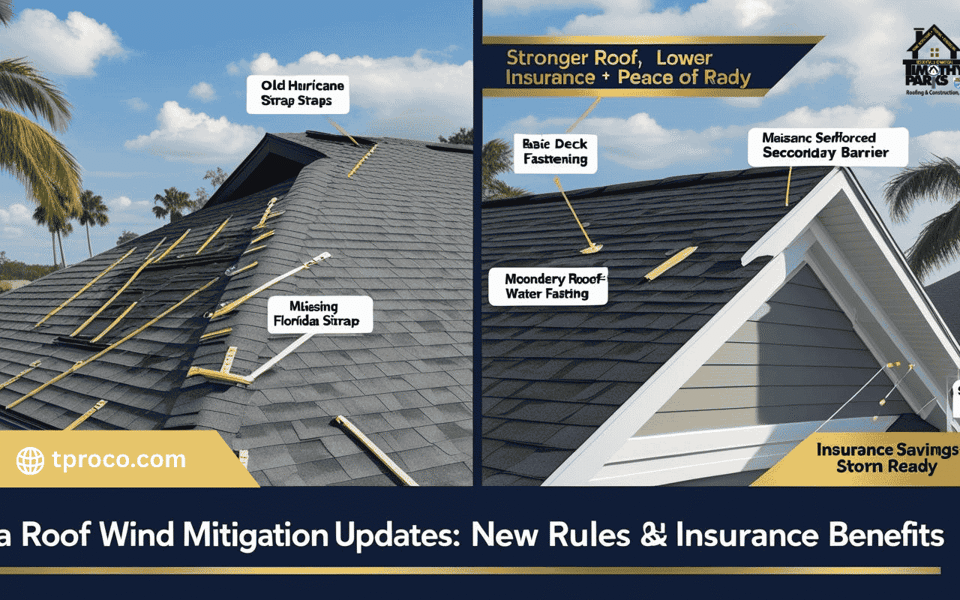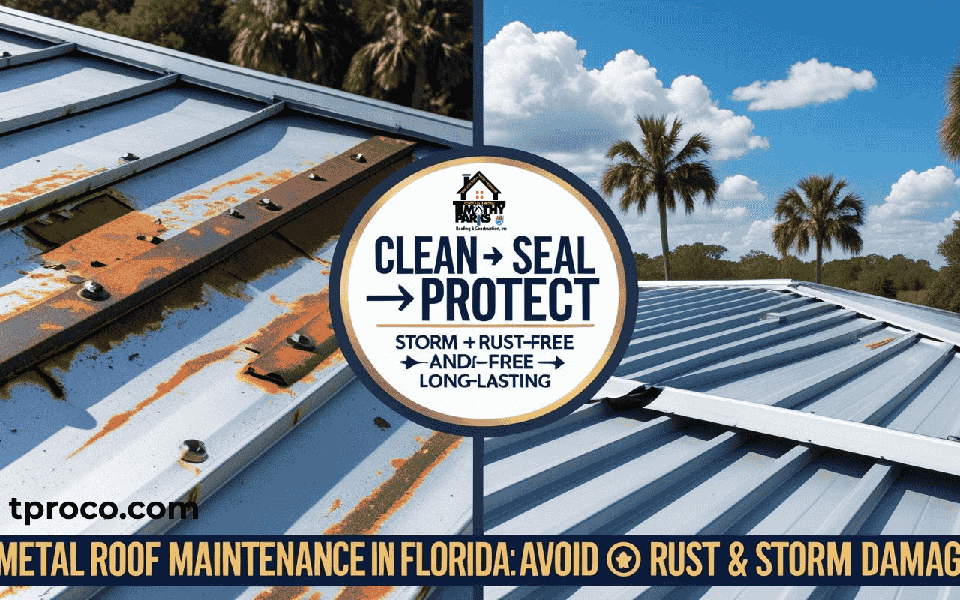Our Blogs
Partial Re-Roofing in Florida: Balancing Cost and Storm Resilience 🔨
Roof damage doesn’t always span your entire home’s surface, especially in Florida where wind gusts might target just one area or an aging valley might fail while the rest remains healthy. A partial re-roof—removing and replacing one roof plane or section—can save money compared to a full roof replacement. Yet it’s not always straightforward: Florida’s building codes may require up-to-date underlayment or decking improvements, color matching can be tricky, and insurance policies might complicate coverage. In this blog, we’ll explore the pros and cons of partial re-roofing in Florida, outlining when it’s a smart investment and when you’re better off replacing everything for storm-level resilience.

Why Consider a Partial Re-Roof?
A partial re-roof can be appealing if:
- Local Damage: A tree limb falls on one side, or a single slope has chronic leaks due to subpar underlayment, while the rest looks fine.
- Cost Savings: Tearing off and replacing fewer squares of shingles or tiles reduces labor and material expenses.
- Roof Age Discrepancy: If most of your roof is 10 years old but a portion was poorly installed 5 years ago, focusing on that trouble zone might suffice.
This approach spares you from paying for an entire roof if 80% remains in decent shape. Florida homeowners often do partial replacements after localized storm damage, especially if insurance only pays for that section. However, partial solutions must still align with local codes, which can mandate larger upgrades if certain percentages of the roof are replaced.
Florida Code & Insurance Nuances
While partial re-roofs are technically permissible, Florida’s building codes have specific triggers:
25% Rule (In Some Jurisdictions):
If more than 25% of a roof is replaced within a 12-month period, the entire system may need updating to current code. This means if your partial re-roof crosses that threshold, you might be forced into a full-scale replacement anyway.
Wind Mitigation Requirements:
Even a partial job might require improved decking attachments, additional underlayment layers, or sealed roof deck methods if local HVHZ (High-Velocity Hurricane Zone) rules apply.
Insurance Stipulations:
Some insurers balk at partial fixes, especially if the rest of the roof is near end-of-life. They may only continue coverage if all planes meet certain wind-uplift standards or if the color difference isn’t excessive.
Before finalizing a partial re-roof, confirm the scope doesn’t trigger a code-mandated full replacement. Also consult your insurer about coverage and premium implications—particularly if storm damage is involved. If you fail to upgrade to new code requirements, future claims may be denied or severely underpaid.
Matching Materials & Color Blending
One potential drawback of partial re-roofing is mismatched appearance, which can be noticeable on Florida’s sloped roofs. Some solutions:
Install on Less Visible Areas:
If you only re-roof a back slope or side that’s not street-facing, color differences might be less obvious.
Use Matching Shingle Batches:
If your original shingles are still manufactured, order from the same color line. Expect some minor shade differences if your older roof has faded under Florida’s UV.
Blend or Transition:
Experienced roofers sometimes “feather in” new shingles over a gradual overlap with older ones, helping the eye adjust.
Consider Accent/Contrast Colors:
For tile roofs, a partial area might be re-tiled in a complementary color if an exact match is unobtainable. This approach can look intentional, though it takes design finesse.
Remember that Florida’s intense sun bleaches asphalt, tile glazes, or metal finishes over time. Even if you find an identical product line, it likely won’t match perfectly. Factor in how important uniformity is to you—especially if you plan to sell soon. A buyer might raise concerns about a two-toned roof, potentially affecting the sale price or timeline. If aesthetics are paramount, a full re-roof may be the more satisfying option.
Step-by-Step Partial Re-Roof Process
If you decide partial re-roofing is the right path, here’s a typical workflow:
- Inspect & Measure: Identify which slopes or sections need replacement. Mark the boundaries—often following ridges, valleys, or roof-plane edges.
- Obtain Permits & Check Code: Florida counties require roofing permits, even for partials. Ensure your scope doesn’t inadvertently exceed the 25% rule (if applicable).
- Tear-Off: Remove old shingles, tiles, or metal panels down to the decking. Dispose of debris responsibly—some Florida regions have special disposal rules for roofing waste.
- Deck & Underlayment Upgrades: Replace rotted plywood or OSB, apply a code-compliant underlayment (peel-and-stick or synthetic). If required, add ring-shank nails for better wind uplift.
- Install New Roofing Material: Match the brand, color, and style as closely as possible. Overlap with existing materials carefully so water can’t sneak between old and new sections.
- Final Inspection & Warranty: Many Florida roofers provide a workmanship warranty. Have the local building department inspect if mandated. Keep all documentation in case of an insurance claim later.
By following these steps meticulously, you ensure your partial re-roof isn’t a patchwork fix but a robust, code-compliant solution. With Florida’s frequent storms, thoroughness matters—cutting corners can lead to repeated leaks or insurance headaches.
Conclusion
🔨 Partial re-roofing can be a cost-effective lifeline if a single slope or section of your Florida roof suffers damage while the rest remains sound. Yet code restrictions, insurance nuances, and color-matching hurdles require a careful approach. Before settling on a partial fix, confirm you won’t cross percentage triggers that force a full replacement. Ensure any new underlayment meets current storm standards, and strive for the best color match possible. When done properly, you’ll enjoy renewed protection over the failing area without paying for a total tear-off. Just keep an eye on the remaining roof sections—Florida’s climate spares no weak spots for long.
Frequently Asked Questions (FAQ)
🔨 Considering a Partial Re-Roof in Florida?
Not every roof needs a full replacement! Learn when a partial re-roof can save you money while still meeting Florida’s codes and offering storm protection.
#tproco #tppro #tprci #urro #rrfl
#PartialReroof #FloridaCode #StormReady #MiamiDade #OrlandoRoof #SunshineState
Schedule a Free InspectionAbout the Author

Timothy Parks
CEO
📢 Stay Informed: Communication & Consent Updates
At Timothy Parks Roofing & Construction Inc., we prioritize transparency in our communications. By submitting a request, you agree to receive calls, texts, and emails regarding our services. Standard messaging rates may apply. You can opt-out at any time by replying STOP or contacting us directly.
✅ Florida License: #CBCO59592, #CCC1327217, #HI4878
📌 Privacy & Terms: Read our Privacy Policy and Terms of Service.




